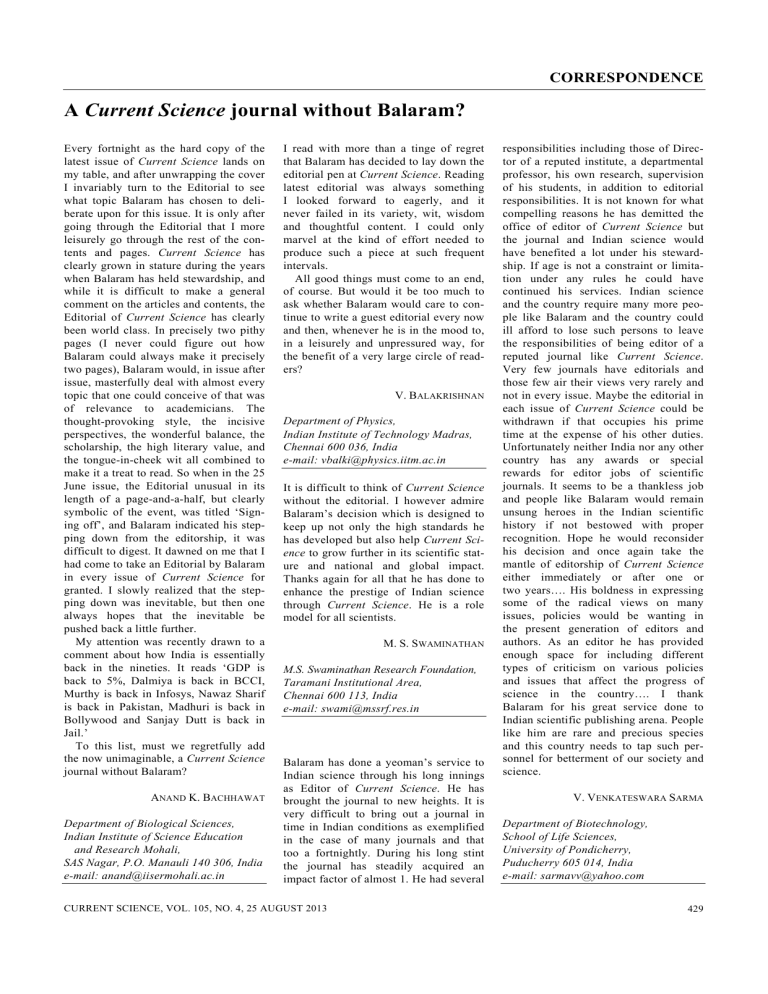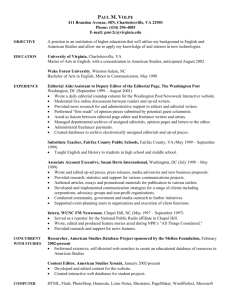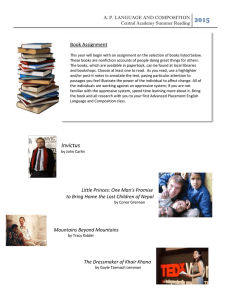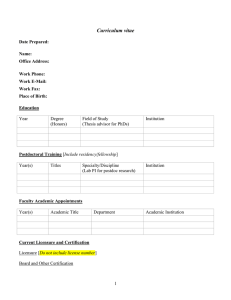Current Science CORRESPONDENCE
advertisement

CORRESPONDENCE A Current Science journal without Balaram? Every fortnight as the hard copy of the latest issue of Current Science lands on my table, and after unwrapping the cover I invariably turn to the Editorial to see what topic Balaram has chosen to deliberate upon for this issue. It is only after going through the Editorial that I more leisurely go through the rest of the contents and pages. Current Science has clearly grown in stature during the years when Balaram has held stewardship, and while it is difficult to make a general comment on the articles and contents, the Editorial of Current Science has clearly been world class. In precisely two pithy pages (I never could figure out how Balaram could always make it precisely two pages), Balaram would, in issue after issue, masterfully deal with almost every topic that one could conceive of that was of relevance to academicians. The thought-provoking style, the incisive perspectives, the wonderful balance, the scholarship, the high literary value, and the tongue-in-cheek wit all combined to make it a treat to read. So when in the 25 June issue, the Editorial unusual in its length of a page-and-a-half, but clearly symbolic of the event, was titled ‘Signing off’, and Balaram indicated his stepping down from the editorship, it was difficult to digest. It dawned on me that I had come to take an Editorial by Balaram in every issue of Current Science for granted. I slowly realized that the stepping down was inevitable, but then one always hopes that the inevitable be pushed back a little further. My attention was recently drawn to a comment about how India is essentially back in the nineties. It reads ‘GDP is back to 5%, Dalmiya is back in BCCI, Murthy is back in Infosys, Nawaz Sharif is back in Pakistan, Madhuri is back in Bollywood and Sanjay Dutt is back in Jail.’ To this list, must we regretfully add the now unimaginable, a Current Science journal without Balaram? ANAND K. BACHHAWAT Department of Biological Sciences, Indian Institute of Science Education and Research Mohali, SAS Nagar, P.O. Manauli 140 306, India e-mail: anand@iisermohali.ac.in I read with more than a tinge of regret that Balaram has decided to lay down the editorial pen at Current Science. Reading latest editorial was always something I looked forward to eagerly, and it never failed in its variety, wit, wisdom and thoughtful content. I could only marvel at the kind of effort needed to produce such a piece at such frequent intervals. All good things must come to an end, of course. But would it be too much to ask whether Balaram would care to continue to write a guest editorial every now and then, whenever he is in the mood to, in a leisurely and unpressured way, for the benefit of a very large circle of readers? V. BALAKRISHNAN Department of Physics, Indian Institute of Technology Madras, Chennai 600 036, India e-mail: vbalki@physics.iitm.ac.in It is difficult to think of Current Science without the editorial. I however admire Balaram’s decision which is designed to keep up not only the high standards he has developed but also help Current Science to grow further in its scientific stature and national and global impact. Thanks again for all that he has done to enhance the prestige of Indian science through Current Science. He is a role model for all scientists. M. S. SWAMINATHAN M.S. Swaminathan Research Foundation, Taramani Institutional Area, Chennai 600 113, India e-mail: swami@mssrf.res.in Balaram has done a yeoman’s service to Indian science through his long innings as Editor of Current Science. He has brought the journal to new heights. It is very difficult to bring out a journal in time in Indian conditions as exemplified in the case of many journals and that too a fortnightly. During his long stint the journal has steadily acquired an impact factor of almost 1. He had several CURRENT SCIENCE, VOL. 105, NO. 4, 25 AUGUST 2013 responsibilities including those of Director of a reputed institute, a departmental professor, his own research, supervision of his students, in addition to editorial responsibilities. It is not known for what compelling reasons he has demitted the office of editor of Current Science but the journal and Indian science would have benefited a lot under his stewardship. If age is not a constraint or limitation under any rules he could have continued his services. Indian science and the country require many more people like Balaram and the country could ill afford to lose such persons to leave the responsibilities of being editor of a reputed journal like Current Science. Very few journals have editorials and those few air their views very rarely and not in every issue. Maybe the editorial in each issue of Current Science could be withdrawn if that occupies his prime time at the expense of his other duties. Unfortunately neither India nor any other country has any awards or special rewards for editor jobs of scientific journals. It seems to be a thankless job and people like Balaram would remain unsung heroes in the Indian scientific history if not bestowed with proper recognition. Hope he would reconsider his decision and once again take the mantle of editorship of Current Science either immediately or after one or two years…. His boldness in expressing some of the radical views on many issues, policies would be wanting in the present generation of editors and authors. As an editor he has provided enough space for including different types of criticism on various policies and issues that affect the progress of science in the country…. I thank Balaram for his great service done to Indian scientific publishing arena. People like him are rare and precious species and this country needs to tap such personnel for betterment of our society and science. V. VENKATESWARA SARMA Department of Biotechnology, School of Life Sciences, University of Pondicherry, Puducherry 605 014, India e-mail: sarmavv@yahoo.com 429 CORRESPONDENCE I have read the recent editorial and have noted that Balaram will be stepping down as editor, Current Science shortly. I would like to thank him for what he has done for this journal, and for his editorials that were both thought provoking and informative. The state of any scientific journal can only reflect, in the end, the state of science, thought and morality in the country of origin. This is true, by the way, even for journals that have a considerable foreign authorship. I am sure that Current Science too will progress to new heights and capture the new ethos that is finally coming into this country, in all walks of life. His editorials have contributed in no small way to what I see as the beginning of a more mature phase of Indian science, because he was never cynical and he never wrote anything that undermined the idealism of young scientists. definite spiritual, cultural and linguistic base to present his scientific opinion. This fast dwindling of indigenous species is no doubt a matter of concern in the present fast food world. DHANAPPA M. METRI ANANTANARAYANAN RAMAN Department of English, Sangameshwara College, Solapur 413 001, India e-mail: metri_dmm@yahoo.com All good things must also end and so has Balaram’s tenure as the editor of Current Science. He has done a fantastic job for a long time, and the scientific community is grateful to him for this service to science despite the pressure on his time. We will miss his editorials. I am sure Srinivasan will continue to keep the flag flying just as Balaram did after Ramaseshan. GAUTAM R. DESIRAJU MAHTAB S. BAMJI Solid State and Structural Chemistry Unit, Indian Institute of Science, Bangalore 560 012, India e-mail: gautam_desiraju@yahoo.com I thank Balaram, the outgoing editor of Current Science journal, whose articles I would never like to miss. The high standards, clarity, depth and diversities of the subjects he has touched upon in his editorials made me become his fan. His editorials were undoubtedly very educative and I will always cherish my fond memories of reading them irrespective of wherever I was. VINAY GANAPATHI e-mail: vnayganapathi@gmail.com Balaram’s inevitable signing off came as a shock but his presence will persist with us at least for a few more issues to come. His non-repetitive feast of the editorial would be the part of our reading the fresh issues of Current Science every time. Every editorial, the outcome of his indiscriminate reading was his specialty that made the reader love science. Every concern he coined made us to meditate and toying with it attracted the attention of the world. In these days of super specialty we are definitely loosing fast the multi-disciplinary scholars. He has the 430 On the whole, I think he can hand over the responsibility to Srinivasan with a high sense of achievement and fulfillment. As I hear from different circles, the image of Current Science has risen to greater heights, after he took over. He is leaving a rich legacy…. 211, Sri Dattasai Apartments, RTC Cross Road, Hyderabad 500 020, India e mail: msbamji@gmail.com I read about Balaram’s decision to hand over the editorial responsibility of Current Science to R. Srinivasan from the July 2013 issue. His decision could be good from the perspective of enabling others learning to handle the responsibility and also from the perspective of injecting a different approach in the management of Current Science, which I have always considered the flagshipscience journal of India. Balaram steered Current Science to immense heights in the global-science documentation scenario. While upholding and maintaining the unique heritage established by C. V. Raman, Balaram sitting in the driver’s seat drove Current Science imaginatively, creatively and impressionably. His editorials were impeccable and spot on science and science-management issues of India; he encouraged a global participation in a frank manner, which has enabled a wider participation of people interested genuinely in Indian science. Most significantly he enabled the perception of science holistically, incorporating an appreciation of the art that laces science finely and delicately. School of Agricultural and Wine Sciences, Charles Sturt University, PO Box 883, Orange, NSW 2800, Australia e-mail: araman@csu.edu.au I wish Balaram well upon his signing off from Current Science; his perspicacity and integrity will be missed. I became acquainted with Current Science when I encountered a paper by associate editor K. R. Rao entitled ‘Nuclear reactor at the core of the Earth! – A solution to the riddles of relative abundances of helium isotopes and geomagnetic field variability’ (Curr. Sci., 2002, 85(2), 127). Here, I realized is a journal that treats science with openness and objectivity that has nearly disappeared in America, and I am extremely grateful for that. Almost 10 years ago, I received an e-mail from P. K. Iyengar, father of India’s atomic bomb, saying that he would be visiting his daughter in San Diego and asking if we might meet. We met for about 2½ hours; the whole time it was as if my brain was on fire, ablaze with a cascade of new ideas and thoughts that seemed to burst forth from conversation with this very exceptional scientist. As a result of that discussion, ultimately I came to understand a natural mechanism for georeactor stability. But something else came from that discussion, a poignant reminder of America’s loss of the lively debate and discussion that should rightly be a part of science. As you progress forward, I suspect one thing will not change – Balaram’s interest in making Indian science better and better. Kindly permit me to offer one suggestion: India should avoid copying the example set by America. In 1951, the U.S. National Science Foundation (NSF) was established and quite literally wrote the rules for how the government would administrate science funding. But NSF made several mistakes that have been eroding and corrupting American science CURRENT SCIENCE, VOL. 105, NO. 4, 25 AUGUST 2013 CORRESPONDENCE since that time, see http://www.nuclearplanet.com/corruption.pdf. J. MARVIN HERNDON Transdyne Corporation, 11044 Red Rock Drive, San Diego, CA 92131, USA e-mail: mherndon@san.rr.com It is sad that Balaram has stepped down as the Editor of Current Science. Of course, one cannot go on for ever. We will miss his incisive and instructive editorial very much. Personally, I learnt a lot reading them. A couple of my colleagues and I used to appreciate the column both for its scientific content and the style of the language, a rare combination indeed. And, he was forthright in expressing his opinion – I remember one such instance where he quoted Robert Southey’s poem After Blenheim to support his view. The journal escalated in its popularity during his tenure and it owes a lot to him. T. S. SURYANARAYANAN Vivekananda Institute of Tropical Mycology, Ramakrishna Mission Vidyapith, Chennai 600 004, India e-mail: t_sury2002@yahoo.com Papers from India and China in Nature: the role of international scientific collaboration Mahesh1 studied how contributions from India and China to Nature have changed over the years. Nature, with its high impact factor and multidisciplinary orientation occupies an iconic position. Mahesh traced the contributions from India and China in this journal using the Science Citation Index-Expanded for the period 1945 till date. On a zeroth-order basis2, counting only the number of publications (P), India and China have had 572 and 588 papers each. But on a firstorder basis, when citations (C) are used as a proxy for scientific performance, China is far ahead of India (75,688 versus 23,404). Thus if impact (i = C/P) is used as a proxy for quality of scientific output, China’s impact is 128.72 citations/paper while that of India is only 40.92 citations/paper. Further, Mahesh1 shows that the number of papers India has published in Nature has actually fallen in recent years even while its total scientific output has increased across the board. One aspect that does not easily reveal itself is the role that international collaboration plays. Papers from India and China that appear in Nature have significantly larger than usual international collaboration and consequently significant increases in impact. In this paper, we critically examine this issue. The extent to which co-publication through international collaboration enhances the value of scientific output of the two countries is calibrated using an index of foreign collaboration3. This can easily be done using a second-order analysis2. The second-order indicator2 is X = C2/P. As we shall see below, the truly indigenous papers from China and India contribute only a small fraction of the total impact compared to papers with international collaboration. Bibliometric data were accessed from the Web of Science (a Thomson Reuters product) on 14 June 2012. A publication window of five years (1996–2000) is taken and all the papers (P) published in Nature where there is at least one author from India or China respectively, are counted. Then the total citations (C) obtained by the papers in this journal during a citation window (chosen as the single year 2001) is found. The impact i = C/P will serve as a proxy for the quality of the output of each publication set. The performance of each country is then tracked using the (i, C, X) parameter space over a rolling window of five years (publication years 1996–2000 to 2006– 2010, implying citation windows which are rolled from 2001 to 2011). Note that P, C and X are the zeroth, first and second-order indicators of scientific performance. By rolling the windows thus it is possible to see how the performance of the two countries has evolved over this time-period. We now discriminate the papers into two categories, those where all the authors are from indigenous institutions (in this case Indian or Chinese) and those with foreign collaboration (where at least one author has an affiliation which is outside India or China respectively). Following Basu and Aggarwal4, any paper with at least one author with an address from India (or China) is taken as the total output P from India (or China) for that year. If a paper contains no address originating outside India (or China), then it is regarded as indigenous production PI. The difference CURRENT SCIENCE, VOL. 105, NO. 4, 25 AUGUST 2013 is then taken as the foreign collaborative (international) output of the institution PF. Whole counting is used throughout, i.e. full credit has been given to each institution regardless of the order or number of author names or relative positions of addresses. The disaggregation into indigenous (Indian or Chinese) and international (foreign) is carried out thus: P = P I + PF, C = C I + CF, i = C/P, iI = CI /PI, iF = CF /PF, From this we have X = iC, X I = i IC I , XF = iFCF. and E = X I + XF The interesting case where i = iI = iF is one of perfect equality of collaboration. In such a case, E = XI + XF = X. Where collaboration is between unequal partners, which is almost universally the case, E > X. This offers the following possible metric: IoFC = XF /E = XF /(XI + XF), 431



